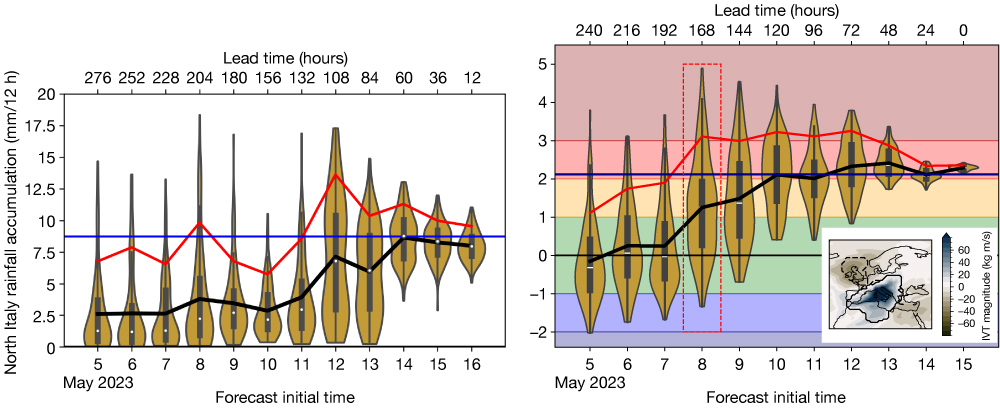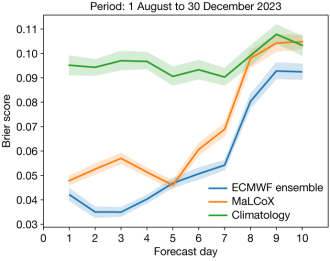ECMWF has taken part in a project that aimed to increase the lead time for early warnings by ensuring that the forecasting of extreme events is dynamically informed. In this ‘Transfer Project’ of the collaborative research centre Waves to Weather (SFB/ TRR165) funded by the German Research Association (DFG), two forecast prototypes, DOMINO and MaLCoX, were developed. It was realised together with scientists at the Karlsruhe Institute of Technology (KIT, Germany), the University of Munich (Germany), and the Italian regional meteorological service of Emilia-Romagna (ARPAE). ECMWF’s role came about through its collaboration with ECMWF Fellow Christian Grams and his group at KIT. The central aim was to make use of the wealth of knowledge about dynamical precursors for extreme events. While the prototypes showcase heavy precipitation events in northern Italy, they are generally applicable to any type of weather event for which some understanding of dynamical precursors is available.
Forecasting extreme weather events is the most important task of operational numerical weather prediction (NWP). However, predicting details of local extremes beyond 1–3 days in advance remains challenging. Research has shown that most events have specific large-scale dynamical precursors, which depend upon the type of extreme weather, the region, and the season. For instance, springtime heavy precipitation events in northern Italy are typically embedded in a highly amplified Rossby wave pattern downstream of a trough in a region of enhanced integrated water vapour transport (IVT). Such dynamical precursors can provide a narrative chain of the unfolding of an extreme event. However, operational forecasting procedures do not yet systematically incorporate this knowledge.
DOMINO
The first tool, DOMINO (Dorrington et al., 2024a, https://doi.org/10.1002/qj.4622), focuses on the large-scale circulation patterns that modulate the likelihood of extreme events. Given a list of extreme event dates, the framework automatically identifies the precursor patterns in any set of candidate variables in ECMWF's ERA5 reanalysis, e.g. 500 hPa geopotential height (Z500) or IVT. Based on these patterns, DOMINO computes a standardised ‘activity index’, which estimates the probability of an extreme. An elevated precursor activity occurred for northern Italy during 15–17 May 2023, resulting in devastating floods in the Emilia-Romagna region. The medium-range ensemble precipitation forecast of ECMWF’s Integrated Forecasting System (IFS) indicated the extreme event with a lead time of about 3 days. However, only 1.5 days before the event (forecast initialised on 14 May) did the ensemble centre around the observed precipitation (see the first plot of the figure and Dorrington et al., 2024b, https://doi.org/10.5194/nhess-24-2995-2024). In contrast, already from 8 May the Z500 and IVT precursors showed elevated risk with the ensemble median slightly above a pre‑warning level (yellow >1) and 25% of the ensemble members above 2 (red) for IVT (see the second plot of the figure). Thus the dynamical precursor ensemble forecast indicated the event 2–5 days earlier compared to direct precipitation forecasts, extending the lead time for early warnings from 3 days to up to 8 days. DOMINO also makes it possible to explore a potential predictability barrier for an event and to assess – a priori – when a forecast becomes more reliable (details in Dorrington et al., 2024b).

MaLCoX
The second tool, MaLCoX (Machine Learning model predicting Conditions for eXtreme precipitation, Grazzini et al., 2024, https://doi.org/10.1002/qj.4755), recognises favourable synoptic conditions leading to precipitation extremes and subsequently classifies extremes into three different categories according to the presence of convection. It is tailored for extreme precipitation events in northern and central Italy but is extensible to other regions and timescales. MaLCoX, which is based on random forest architecture, uses different groups of predictors, including local (point-based) predictors and the precursor indices from DOMINO as non-local (field-based) predictors. The non-local predictors are particularly relevant and increase the skill of MaLCoX for medium-range lead times > 6 days.
MaLCoX has been implemented operationally at ARPAE Emilia-Romagna (Bologna) and shows comparable skill to direct precipitation output from the ensemble, in particular in situations with strong dynamical forcing (see the second figure). This is remarkable as MaLCoX is solely trained on the control forecast and currently uses no dynamical ensemble information as input. An advantage over ensemble forecasts comes from interpretability. MaLCoX is able to attribute its decision (extreme ‘yes’ or ‘no’, and category) to individual components, thus providing forecast products which allow dynamical insights (e.g. anomalous IVT values vs. wave amplitude). Understanding why a model makes a certain prediction can be as crucial as the prediction's accuracy, especially when forecasters have to face rare conditions and they need to gain trust in model output.

Applicability
According to discussions with forecasters at ARPAE Emilia-Romagna and MeteoSwiss, such early warnings based on dynamical precursors are particularly useful for ‘low regret’ actions, for which measures to mitigate negative impacts can be taken at a low cost and some false alarms are acceptable. The MaLCoX suite at ARPAE Emilia-Romagna (Bologna) is already fine-tuned for heavy precipitation events in northern Italy, and it runs operationally at ARPAE. For more information, please contact Frederico Grazzini. The DOMINO workflow is implemented on ECMWF’s ecgate server and is available to ECMWF Member States as an easy-to-use preconfigured software package. For more information, please contact Linus Magnusson, Christian M. Grams, or Joshua Dorrington.
